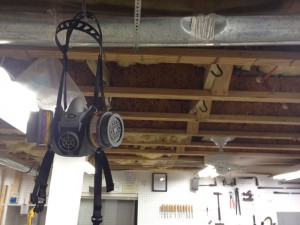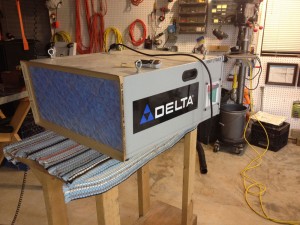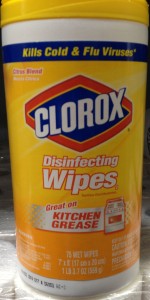No Southern-fried Southern boy wants to be called a Yankee, but we share the characteristics of shrewdness and thrift. Thus, each month we include a money-saving tip. It’s OK if you call me “cheap.”
Sticking with the dust theme from Tip #1… The inside of your dust mask can become very wet, owing to the high moisture content of your breath. My tip? Install a hook in front of the outflow side of your ceiling-mounted air filter or air-circulating fan. Hang your mask in front of it with the inside facing the air flow and it will be nice and dry the next time you use it.

Free mask drying here! Every time you turn on the air filter the moist inside of your mask is dried automatically. You have to use your imagination a bit. This is the mask’s usual hanging place and the filter’s usual mounting place. However, I currently have it on a rolling stand while we’re having new wood floors installed in our living room.

I’m thinking of leaving the dust filter on this cart, as it’s now closer to “nose level” and may be more effective. If so, I’ll have to rig a new hanging place for the dust mask.
If the mask develops a sour smell, indicating mold and mildew are growing there, wipe it out with a Clorox Bleach Wipe or a paper towel wetted with vinegar, then allow it to air out thoroughly before reusing.

Clorox wipes have just the right amount of chlorine to kill the smell but not leave chlorine fumes the next time you wear your mask.
Jim Randolph is a veterinarian in Long Beach, Mississippi. His earlier careers as lawn mower, dairy farmer, automobile mechanic, microwave communications electronics instructor and journeyman carpenter all influence his approach to woodworking. His favorite projects are furniture built for his wife, Brenda, and for their children and grandchildren. His and Brenda’s home, nicknamed Sticks-In-The-Mud, is built on pilings (sticks) near the wetlands (mud) on a bayou off Jourdan River. His shop is in the lower level of their home. Questions and comments on woodworking may be written below in the comments section. Questions about pet care should be directed to his blog on pet care, www.MyPetsDoctor.com. We regret that, because of high volume, not all inquiries can be answered personally.


Regarding this tip on keeping your dust mask dry, clean and sweet-smelling with nearly zero effort, retired safety engineer, John Cole, was nice enough to send this suggestion from industry. We are always grateful for readers who respond with helpful comments. Photos are always great, too!
John says, “Respirators can be cleaned by washing in a dishwasher or washing machine. But, not the paper filters, though! I rinse the body and straps again in clean water if I used the dishwasher. Dry with paper towel and air dry as needed. I am referring to silicone, rubber and plastic types, as shown. Don’t forget your hearing and eye protection.” John Cole, retired safety engineer
I keep a respirator that just sticks in your mouth for those little jobs that arn,t worth getting out a mask
Ed, I would love to see a respirator like that. Could you write back with your email address and then we can make arrangements for you to send me a photo. Thanks! Jim